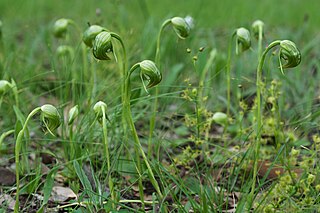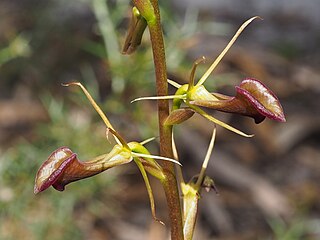
Caladenia, commonly known as spider orchids, is a genus of 350 species of plants in the orchid family, Orchidaceae. Spider orchids are terrestrial herbs with a single hairy leaf and a hairy stem. The labellum is fringed or toothed in most species and there are small projections called calli on the labellum. The flowers have adaptations to attract particular species of insects for pollination. The genus is divided into three groups on the basis of flower shape, broadly, spider orchids, zebra orchids and cowslip orchids, although other common names are often used. Although they occur in other countries, most are Australian and 136 species occur in Western Australia, making it the most species-rich orchid genus in that state.

Pterostylis nutans, commonly known as the nodding greenhood or the parrot's beak orchid, is a species of orchid endemic to eastern Australia. Nodding greenhoods have flowers which "nod" or lean forwards strongly, have a deeply notched sinus and a curved, hairy labellum.

Cryptostylis, commonly known as tongue orchids, is a genus of flowering plants from the orchid family. Tongue orchids are terrestrial herbs with one to a few stalked leaves at the base of the flowering stem, or leafless. One to a few dull coloured flowers are borne on an erect flowering stem. The most conspicuous part of the flower is the labellum, compared to the much reduced sepals and petals. At least some species are pollinated by wasps when they attempt to mate with the flower. There are about twenty five species found in South Asia, Southeast Asia and the South Pacific.

Cryptostylis hunteriana, commonly known as the leafless tongue-orchid is a flowering plant in the orchid family Orchidaceae and is endemic to south eastern Australia. It is leafless but has up to ten green flowers with a more or less erect, dark reddish brown labellum.

Cryptostylis erecta, commonly known as the bonnet orchid or tartan tongue orchid , is an orchid endemic to south eastern Australia. A small and common plant, it has dark green lance-shaped to egg-shaped leaves and up to twelve greenish flowers with a large, bonnet-like or hood-like, lilac-coloured labellum with a network of purple veins.

Cryptostylis subulata, commonly known as the large tongue orchid, duckbill orchid or cow orchid, is a common and widespread orchid in south eastern Australia and New Zealand. It has relatively large, leathery, dark green to yellowish-green leaves and up to twenty yellowish flowers with a reddish-brown and dark purple labellum. It is often found in damp or swampy situations but also occurs in drier places.

Spathoglottis paulinae, commonly known as the small purple orchid, is a plant in the orchid family and is native to New Guinea and Tropical North Queensland. It is an evergreen terrestrial orchid with crowded pseudobulbs, between four and seven large, pleated leaves and up to thirty mauve to purple flowers.

Arthrochilus latipes, commonly known as robust elbow orchid, is a flowering plant in the orchid family (Orchidaceae) and is endemic to the "Top End" of the Northern Territory in Australia. Each plant has from two to four ground-hugging leaves and between three and fifteen flowers during the wet season and the species often forms spreading colonies on sandstone escarpments. Like others in the genus, the flowers are pollinated by a species of thynnid wasp.

Caladenia congesta, commonly known as black-tongue caladenia, is a plant in the orchid family Orchidaceae and is endemic to Australia. It is a ground orchid with a single, sparsely hairy leaf, and up to three bright pink flowers with the central part of the labellum completely covered with black calli. It is a widespread species but not common in any part of its range.
Caladenia leptochila subsp. dentata, commonly known as the toothed spider orchid, narrow-lipped spider-orchid or narrow-lipped caladenia, is a plant in the orchid family Orchidaceae and is endemic to South Australia. It has a single leaf and one or two mostly reddish-brown flowers. It differs from subspecies leptochila in the colour of its flowers, toothed edges to its labellum, and its distribution.

Pterostylis daintreana, commonly known as Daintree's greenhood, is a species of orchid endemic to eastern Australia. The non-flowering plants have a rosette of leaves on short stalks but flowering plants have up to ten flowers with rosettes on the side of the flowering spike. The flowers are translucent white with dark green lines and long, downcurved lateral sepals.

Genoplesium nigricans, commonly known as mallee midge orchid, is a species of orchid endemic to Australia. It is a terrestrial herb with a single leaf mostly surrounding the stem, and up to 50 tiny, greenish flowers with a deep maroon-coloured labellum and often have a fruity fragrance. Australian authorities use the name Corunastylis tepperi, a widespread species which has been confused with Corunastylis nigricans, a species with purplish brown flowers and which only occurs on Kangaroo Island and the Eyre Peninsula.

Diuris abbreviata, commonly known as the lemon doubletail, is a species of orchid that is endemic to eastern Australia. It has two or three leaves and a flowering stem with up to nine yellow flowers with darker markings.

Arthrochilus huntianus, commonly known as common elbow orchid, is a flowering plant in the orchid family (Orchidaceae) and is endemic to south-eastern Australia. It has no leaves but an insect-like flower which has its labellum dangling like a lure away from the rest of the flower. Because of its thin, wiry stem and small, dull-coloured flowers, this orchid is difficult to locate. Like others in the genus, the flowers are pollinated by a species of thynnid wasp. Some authorities use the name Thynninorchis huntiana for this orchid.
Arthrochilus corinnae, commonly known as the swamp elbow orchid, is a flowering plant in the orchid family (Orchidaceae) and is endemic to the northern part of Cape York in Queensland. It has two or three dull bluish green leaves near its base and up to twelve pale green, insect-like flowers with shiny yellowish glands on its labellum.

Arthrochilus irritabilis, commonly known as clubbed elbow orchid, is a flowering plant in the orchid family (Orchidaceae) and is endemic to Queensland. It has up to five leaves and up to thirty light greenish or reddish, insect-like flower with reddish, hair-like glands on its labellum. There is a single record of this species from Papua New Guinea.
Arthrochilus lavarackianus, commonly known as the glaucous truffle orchid, is a species of flowering plant in the orchid family (Orchidaceae) and is endemic to the Torres Strait and Tropical North Queensland. It has one or two bluish green leaves at its base and up to fifteen greenish, insect-like flowers with red glands on its mushroom-like labellum. This species is known by some authorities as Phoringopsis lavarackiana.

Cryptostylis ovata, commonly known as the slipper orchid or western tongue orchid, is an orchid endemic to Western Australia. It is a common, summer flowering species with dark green leaves with a white central vein and up to fifteen pale greenish flowers with a brownish red labellum with a network of darker veins.

Liparis habenarina, commonly known as the common sphinx orchid or common hobgoblin orchid, is a plant in the orchid family and is endemic to Australia. It is a deciduous, terrestrial orchid with two or three egg-shaped leaves and between eight and twenty-two brownish to purplish flowers with their lateral sepals joined at the base. It grows in the understorey of near-coastal forests.
Taeniophyllum muelleri, commonly known as the chain ribbonroot, is a species of leafless epiphytic or lithophytic orchid that usually forms tangled colonies. It has short stems and cylindrical green roots pressed against the substrate on which it is growing. Between five and twelve yellowish green, tube-shaped flowers open one at a time. This orchid occurs in eastern Australia and New Caledonia.
















